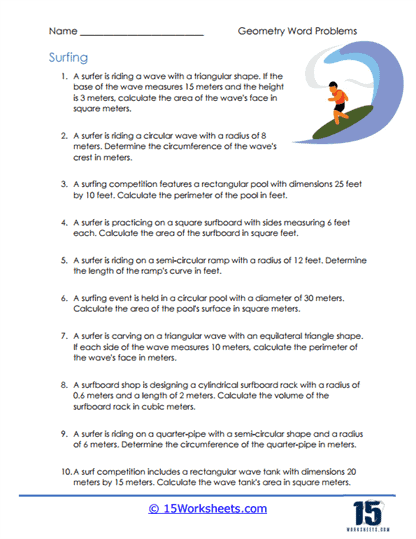Surfing

Worksheet Description
This worksheet merges the sport of surfing with geometry word problems to create an engaging learning tool for students. The problems are designed around various surfing-related scenarios such as riding waves, surfing on different shaped boards, and events held in pools with specific dimensions. Students are tasked with using geometric formulas to calculate areas, perimeters, circumferences, and volumes based on the dimensions provided in each question, all within the thematic setting of surfing.
The objective of the worksheet is to educate students on the practical applications of geometry in the context of a sport that is familiar and exciting to many. It aims to reinforce their understanding of how to compute the area of triangles and rectangles, the circumference of circles, and the volume of cylinders. Additionally, it teaches students to solve real-world problems by employing mathematical concepts, thereby enhancing their problem-solving and critical thinking skills. The worksheet also serves to make geometry more accessible and enjoyable by relating it to an enjoyable activity.
Example Problems
1. A surfer is riding a wave with a triangular shape. If the base of the wave measures 15 meters and the height is 3 meters, calculate the area of the wave’s face in square meters.
2. A surfer is riding a circular wave with a radius of 8 meters. Determine the circumference of the wave’s crest in meters.
3. A surfing competition features a rectangular pool with dimensions 25 feet by 10 feet. Calculate the perimeter of the pool in feet.
4. A surfer is practicing on a square surfboard with sides measuring 6 feet each. Calculate the area of the surfboard in square feet.
5. A surfer is riding on a semi-circular ramp with a radius of 12 feet. Determine the length of the ramp’s curve in feet.
6. A surfing event is held in a circular pool with a diameter of 30 meters. Calculate the area of the pool’s surface in square meters.
7. A surfer is carving on a triangular wave with an equilateral triangle shape. If each side of the wave measures 10 meters, calculate the perimeter of the wave’s face in meters.
